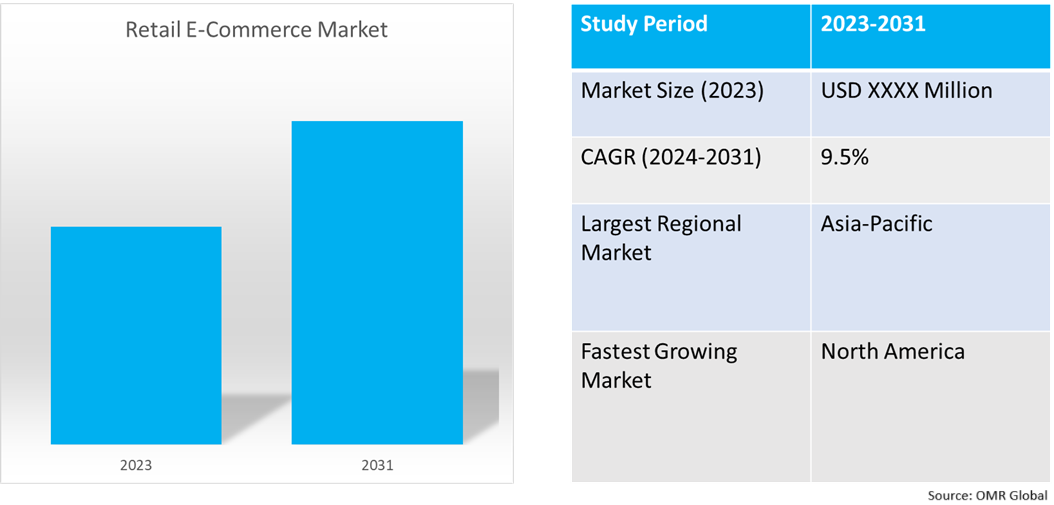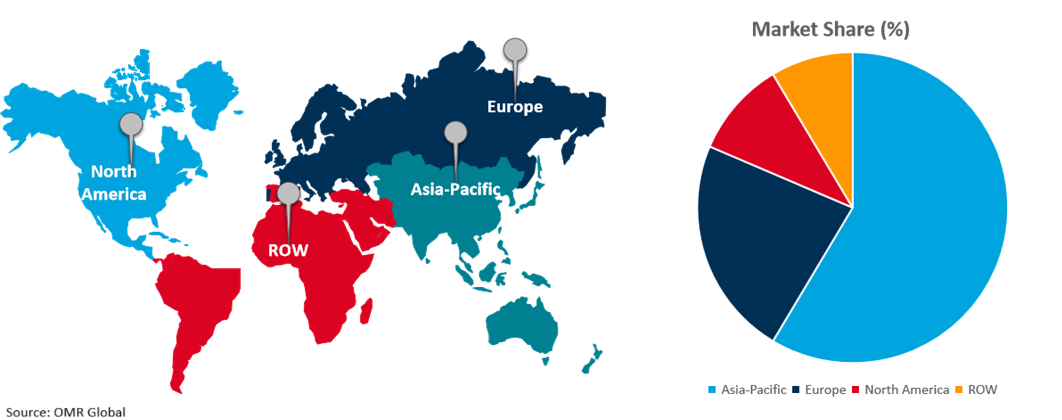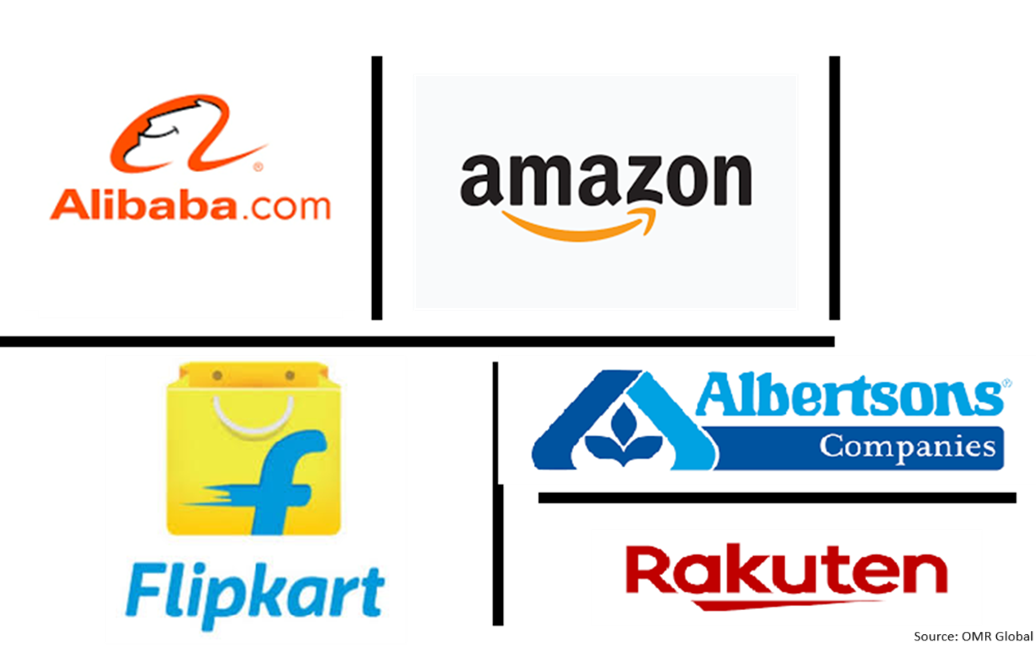Retail E-Commerce Market
Retail E-Commerce Market Size, Share & Trends Analysis Report by Product (Groceries, Apparel & Accessories, Footwear, Personal & Beauty Care, Furniture & Household Décor, Electronic Goods, Others (Books, Movie Tickets & Food Delivery)), and by Type (Pure Market Place and Hybrid Market Place) Forecast Period (2024-2031)
Retail e-commerce market is anticipated to grow at a significant CAGR of 9.5% during the forecast period (2024-2031). The growth of the retail e-commerce market is significantly fueled by the rise in B2B e-commerce sales. As businesses increasingly turn to online platforms for purchasing goods and services, this shift is transforming the landscape of retail commerce. B2B transactions are becoming more streamlined and efficient, allowing companies to reach a broader customer base and enhance their operational capabilities. According to The International Trade Administration, global e-commerce sales for B2B businesses have been steadily rising year over year for the last decade, with the global B2B e-commerce market valued at $36 trillion by 2026. Its revenue is expected to grow to $5.5 trillion by 2027 at a steady 14.4% compound annual growth rate.

Market Dynamics
Increasing adoption of digital technology, which has made online shopping more accessible and convenient for consumers. The proliferation of smartphones and high-speed internet has enabled customers to shop from anywhere, at any time, leading to a significant rise in online purchases. Additionally, the growth of social media and digital marketing has transformed how retailers engage with customers, creating more personalized shopping experiences. Another crucial factor is the expansion of logistics and delivery services, which has improved the efficiency and reliability of online orders. Lastly, the ongoing shift towards contactless payments and enhanced security measures has boosted consumer confidence in online transactions, further driving market growth. Together, these factors are reshaping the retail landscape and contributing to the robust expansion of e-commerce.
Increasing adoption of digital technology
The retail e-commerce market is growing owing to the increasing adoption of digital technology, which has made online shopping more accessible and convenient for consumers. The proliferation of smartphones and high-speed internet has enabled customers to shop from anywhere, at any time, leading to a significant rise in online purchases, as consumers appreciate the ability to shop without the constraints of traditional retail hours.
Enhanced Consumer Experience
The retail e-commerce market is driven by increasing demand for enhanced consumer experiences through advanced technologies like speech recognition. Customers are increasingly using smart speakers to place online orders, as voice searches often lead to more accurate results. Additionally, augmented reality (AR) is gaining traction among retailers, with major companies adopting this technology to differentiate themselves in a competitive market. By investing in AR, e-retailers aim to provide a more immersive shopping experience, allowing customers to visualize products more interactively, ultimately improving usability and satisfaction.
Market Segmentation
- Based on the product, the market is segmented into groceries, apparel & accessories, footwear, personal & beauty care, furniture & household décor, electronic goods, and others (books, movie tickets & food delivery)
- Based on the type, the market is segmented into pure marketplace and hybrid market place
The Apparel and Accessories Segment is Projected to Hold the Largest Market Share
The primary factors supporting the growth include the increasing consumer preference for online shopping, which offers a vast array of choices and convenient purchasing options. As fashion trends evolve rapidly, online platforms allow retailers to quickly showcase new collections and respond to changing consumer demands. Moreover, the integration of advanced technologies, such as virtual fitting rooms and personalized recommendations, enhances the online shopping experience, making it more appealing to customers. Social media also plays a significant role in driving traffic to e-commerce sites, as influencers and targeted advertisements promote fashion items and accessories. Market players for instance, in August 2021, Gap Inc. acquired Drapr which allows customers to create 3D avatars and virtually try on clothing. This technology aims to enhance the shopping experience by helping customers find the right size and fit while reducing unnecessary returns for retailers. Additionally, in August 2022, Virtual fitting rooms such as 3DLOOK’s YourFit, which uses body scanning technology to extract each customer’s unique body measurements, offer retailers an abundance of anonymized data. With this, retailers can tweak their dragging rules, improve distribution, tailor marketing campaigns, and design future products according to the needs and preferences of their most loyal customers.
Groceries Segment to Hold a Considerable Market Share
The factors supporting segment growth include the availability of a wide range of products, from organic options to local specialties attracts consumers to online grocery shopping. With the increasing demand for convenience and the rise of busy lifestyles, more shoppers are turning to online platforms for their grocery needs. According to Think Global Health, in January 2022, during the pandemic online grocery shopping surged as consumers sought safety and convenience amidst store overcrowding and fears of infection. Major retailers like Walmart and Amazon saw significant increases in online sales, with many households planning to continue this trend post-pandemic due to the benefits of diverse food options and convenience.
Regional Outlook
The global retail e-commerce market is further segmented based on geography including North America (the US, and Canada), Europe (the UK, Italy, Spain, Germany, France, and the Rest of Europe), Asia-Pacific (India, China, Japan, South Korea, and Rest of Asia-Pacific), and the Rest of the World (the Middle East & Africa, and Latin America).
Transformation of e-commerce operations drives in Europe
The regional growth is attributed to increasing the demand for the transformation of e-commerce operations. A key component of this strategy is the launch of ZEOS, a new B2B brand designed to support brands and retailers in optimizing their e-commerce operations across Europe’s complex market landscape. For instance, in March 2024, companies like AWWG Group are leveraging ZEOS to effectively navigate the European marketplace, highlighting its potential to transform e-commerce operations in the fashion industry.
Global Retail E-Commerce Market Growth by Region 2024-2031

Asia-Pacific Holds Major Market Share
Asia-Pacific holds a significant share owing to the rapidly growing mobile internet user base and product expansion by strong key players in this region are expected to drive the market. As more people gain access to smartphones and high-speed internet, online shopping becomes more accessible and convenient, encouraging consumers to explore digital platforms for their purchases. According to the India Brand Equity Foundation, As of June 2023, the number of internet connections in India significantly increased to 895 million, driven by the ‘Digital India’ program. Out of the total internet connections, ~55% of connections were in urban areas, of which 97% of connections were wireless. The smartphone base has also increased significantly and is expected to reach 1.1 billion by 2025. For instance, in April 2023, Anko, an Australian brand launched the Amazon India e-commerce platform to deliver high-quality products to Indian consumers. Moreover, according to the International Trade Administration, by recent industry calculations, India will rank first among 20 countries worldwide in retail e-commerce development between 2023 and 2027, with a compound annual growth rate of 14.1%.
Market Players Outlook

*Note: Major Players Sorted in No Particular Order.
The major companies serving the retail e-commerce market include Albertsons Companies, Inc., Amazon.com, Inc., Alibaba Group, Ebay, Inc., Rakuten Rewards, and Flipkart Pvt Ltd. among others. The market players are increasingly focusing on business expansion and product development by applying strategies such as collaborations, mergers, and acquisitions to stay competitive in the market.
Recent Development
- In November 2023, Amazon announced a strategic partnership with Meta that aims to revolutionize online shopping by integrating Meta's popular social media platforms, Facebook and Instagram, with Amazon's vast product selection. This collaboration seeks to enhance the shopping experience, allowing users to discover and purchase products seamlessly through their favorite social channels.
The Report Covers
- Market value data analysis of 2023 and forecast to 2031.
- Annualized market revenues ($ million) for each market segment.
- Country-wise analysis of major geographical regions.
- Key companies operating in the global retail e-commerce market. Based on the availability of data, information related to new products, and relevant news is also available in the report.
- Analysis of business strategies by identifying the key market segments positioned for strong growth in the future.
- Analysis of market-entry and market expansion strategies.
- Competitive strategies by identifying ‘who-stands-where’ in the market.
1. Report Summary
• Current Industry Analysis and Growth Potential Outlook
1.1. Research Methods and Tools
1.2. Market Breakdown
1.2.1. By Segments
1.2.2. By Region
2. Market Overview and Insights
2.1. Scope of the Report
2.2. Analyst Insight & Current Market Trends
2.2.1. Key Market Trends
2.2.2. Recommendations
2.2.3. Conclusion
3. Competitive Landscape
3.1. Key Company Analysis
3.2. alibaba group
3.2.1. Overview
3.2.2. Financial Analysis
3.2.3. SWOT Analysis
3.2.4. Recent Developments
3.3. Amazon.com, Inc.
3.3.1. Overview
3.3.2. Financial Analysis
3.3.3. SWOT Analysis
3.3.4. Recent Developments
3.4. eBay Inc.
3.4.1. Overview
3.4.2. Financial Analysis
3.4.3. SWOT Analysis
3.4.4. Recent Developments
3.5. Walmart Inc.
3.5.1. Overview
3.5.2. Financial Analysis
3.5.3. SWOT Analysis
3.5.4. Recent Developments
3.6. Flipkart Pvt Ltd.
3.6.1. Overview
3.6.2. Financial Analysis
3.6.3. SWOT Analysis
3.6.4. Recent Developments
3.7. Key Strategy Analysis
4. Market Segmentation
4.1. Global Retail E-Commerce Market by Product
4.1.1. Groceries
4.1.2. Apparels & Accessories
4.1.3. Footwear
4.1.4. Personal & Beauty Care
4.1.5. Furniture & Household Décor
4.1.6. Electronic Goods
4.1.7. Others (Books, Movie Tickets & Food Delivery)
4.2. Global Retail E-Commerce Market by Type
4.2.1. Pure Market Place
4.2.2. Hybrid Market Place
5. Regional Analysis
5.1. North America
5.1.1. United States
5.1.2. Canada
5.2. Europe
5.2.1. UK
5.2.2. Germany
5.2.3. Italy
5.2.4. Spain
5.2.5. France
5.2.6. Rest of Europe
5.3. Asia-Pacific
5.3.1. China
5.3.2. India
5.3.3. Japan
5.3.4. South Korea
5.3.5. Rest of Asia-Pacific
5.4. Rest of the World
5.4.1. Latin America
5.4.2. Middle East and Africa
6. Company Profiles
6.1. Albertsons Companies, Inc.
6.2. ASOS Plc
6.3. Best Buy
6.4. Coupang Corp.
6.5. Groupon Inc
6.6. Inter IKEA Systems B.V.
6.7. JD.com
6.8. MercadoLibre Inc
6.9. Newegg
6.10. Noon AD Holdings Ltd
6.11. Otto (GmbH & Co. KG)
6.12. Rakuten, Inc
6.13. Shopify Inc
6.14. Snapdeal Ltd.
6.15. Taobao
6.16. Target Corporation
6.17. The Home Depot
6.18. The Kroger Co.
6.19. Wayfair Inc.
6.20. Zalando SE
1. Global Retail E-Commerce Market Research And Analysis By Product, 2023-2031 ($ Million)
2. Global Groceries E-Commerce Market Research and Analysis By Region, 2023-2031 ($ Million)
3. Global Apparels & Accessories E-Commerce Market Research and Analysis by Region, 2023-2031 ($ Million)
4. Global Footwear E-Commerce Market Research and Analysis by Region, 2023-2031 ($ Million)
5. Global Personal & Beauty Care E-Commerce Market Research and Analysis by Region, 2023-2031 ($ Million)
6. Global Furniture & Household Décor E-Commerce Market Research and Analysis by Region, 2023-2031 ($ Million)
7. Global Electronic Goods E-Commerce Market Research and Analysis by Region, 2023-2031 ($ Million)
8. Global Others Retail E-Commerce Market Research and Analysis by Region, 2023-2031 ($ Million)
9. Global Retail E-Commerce Market Research and Analysis by Type, 2023-2031 ($ Million)
10. Global Pure Retail E-Commerce Market Research and Analysis by Region, 2023-2031 ($ Million)
11. Global Hybrid Retail E-Commerce Market Research and Analysis by Region, 2023-2031 ($ Million)
12. Global Retail E-Commerce Market Research and Analysis by Region, 2023-2031 ($ Million)
13. North American Retail E-Commerce Market Research and Analysis by Country, 2023-2031 ($ Million)
14. North American Retail E-Commerce Market Research and Analysis by Product, 2023-2031 ($ Million)
15. North American Retail E-Commerce Market Research and Analysis by Type, 2023-2031 ($ Million)
16. European Retail E-Commerce Market Research and Analysis by Country, 2023-2031 ($ Million)
17. European Retail E-Commerce Market Research and Analysis by Product, 2023-2031 ($ Million)
18. European Retail E-Commerce Market Research and Analysis by Type, 2023-2031 ($ Million)
19. Asia-Pacific Retail E-Commerce Market Research and Analysis by Country, 2023-2031 ($ Million)
20. Asia-Pacific Retail E-Commerce Market Research and Analysis by Product, 2023-2031 ($ Million)
21. Asia-Pacific Retail E-Commerce Market Research and Analysis by Type, 2023-2031 ($ Million)
22. Rest of The World Retail E-Commerce Market Research and Analysis by Region, 2023-2031 ($ Million)
23. Rest of The World Retail E-Commerce Market Research and Analysis by Product, 2023-2031 ($ Million)
24. Rest of The Retail E-Commerce Market Research and Analysis by Type, 2023-2031 ($ Million)
1. Global Retail E-Commerce Market Research and Analysis By Product, 2023 Vs 2031 (%)
2. Global Groceries E-Commerce Market Share by Region, 2023 Vs 2031 (%)
3. Global Apparels & Accessories E-Commerce Market Share by Region, 2023 Vs 2031 (%)
4. Global Footwear E-Commerce Market Share by Region, 2023 Vs 2031 (%)
5. Global Personal & Beauty Care E-Commerce Market Share by Region, 2023 Vs 2031 (%)
6. Global Furniture & Household Décor E-Commerce Market Share by Region, 2023 Vs 2031 (%)
7. Global Electronic Goods E-Commerce Market Share by Region, 2023 Vs 2031 (%)
8. Global Others Retail E-Commerce Market Share by Region, 2023 Vs 2031 (%)
9. Global Retail E-Commerce Market Research and Analysis by Type, 2023 Vs 2031 (%)
10. Global Pure Retail E-Commerce Market Share by Region, 2023 Vs 2031 (%)
11. Global Hybrid Retail E-Commerce Market Share by Region, 2023 Vs 2031 (%)
12. Global Retail E-Commerce Market Share by Region, 2023 Vs 2031 (%)
13. US Retail E-Commerce Market Size, 2023-2031 ($ Million)
14. Canada Retail E-Commerce Market Size, 2023-2031 ($ Million)
15. UK Retail E-Commerce Market Size, 2023-2031 ($ Million)
16. France Retail E-Commerce Market Size, 2023-2031 ($ Million)
17. Germany Retail E-Commerce Market Size, 2023-2031 ($ Million)
18. Italy Retail E-Commerce Market Size, 2023-2031 ($ Million)
19. Spain Retail E-Commerce Market Size, 2023-2031 ($ Million)
20. Rest of Europe Retail E-Commerce Market Size, 2023-2031 ($ Million)
21. India Retail E-Commerce Market Size, 2023-2031 ($ Million)
22. China Retail E-Commerce Market Size, 2023-2031 ($ Million)
23. Japan Retail E-Commerce Market Size, 2023-2031 ($ Million)
24. South Korea Retail E-Commerce Market Size, 2023-2031 ($ Million)
25. Rest of Asia-Pacific Retail E-Commerce Market Size, 2023-2031 ($ Million)
26. Latin America Retail E-Commerce Market Size, 2023-2031 ($ Million)
27. Middle East and Africa Retail E-Commerce Market Size, 2023-2031 ($ Million)


